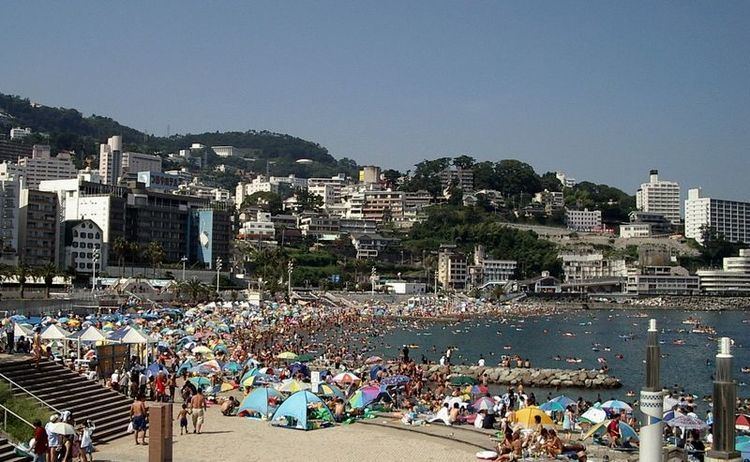Country Japan Prefecture Shizuoka Prefecture | Region Chūbu (Tōkai) Phone number 0557-86-6000 | |
 | ||
Time zone Japan Standard Time (UTC+9) Address 1-1 Chūō-chō, Atami-shi, Shizuoka-ken 413-8550 | ||
Atami (熱海市, Atami-shi) is a city located in the eastern part of Shizuoka Prefecture, Japan.
Contents
- Map of Atami Shizuoka Prefecture Japan
- Geography
- Surrounding municipalities
- History
- Economy
- Education
- Railway
- Highway
- Twin towns Sister cities
- Notable people
- Local attractions
- In popular culture
- References
Map of Atami, Shizuoka Prefecture, Japan
The city, which covers an area of 61.78 square kilometres (23.85 sq mi), had an estimated population in December 2016 of 37,146, giving a population density of 601 persons per km2.
Geography
Atami is located in the far eastern corner of Shizuoka Prefecture at the northern end of Izu Peninsula. The city is on the steep slopes of a partially submerged volcanic caldera on the edge of Sagami Bay. The name "Atami" literally means "hot ocean," a reference to the town's famous onsen hot springs. The city boundaries include the offshore island of Hatsushima. Most of Atami is located within the Fuji-Hakone-Izu National Park. Warmed by the Kuroshio Current offshore, the area is known for its moderate maritime climate with hot, humid summers, and short winters.
Surrounding municipalities
Shizuoka Prefecture
Kanagawa Prefecture
History
Atami has been known as a resort town centered on its hot springs since the 8th century AD. In the Kamakura period, Minamoto Yoritomo and Hōjō Masako were notable visitors. During the Edo period, all of Izu Province was tenryō territory under direct control of the Tokugawa shogunate. During the cadastral reform of the early Meiji period in 1889, Atami village was organized within Kamo District, Shizuoka. It was elevated to town status on June 11, 1894, and was transferred to the administrative control of Tagata District, Shizuoka in 1896.
The epicenter of the Great Kantō earthquake in 1923 was deep beneath Izu Ōshima Island in Sagami Bay, close to Atami, which suffered considerable damage, as did other municipalities throughout the surrounding Kantō region. The tsunami wave height reached 35 feet at Atami, swamping the town and drowning three hundred people.
The modern city of Atami was founded on April 10, 1937, through the merger of Atami Town with neighboring Taga Village. After the proclamation of Atami as an "International Tourism and Culture City" by the Japanese government in 1950, the area experienced rapid growth in large resort hotel development. This growth increased after Atami station became a stop on the Tōkaidō Shinkansen high-speed train line in 1964. In concert with its famous onsen, Atami was known for its onsen geisha. Atami experienced a considerable decline in popularity as a vacation destination due to the Japanese economic crisis in the 1990s and the associated fall in large group company-sponsored vacations, but is currently experiencing a revival as a bedroom community due to its proximity to Tokyo and Yokohama.
The Inagawa-kai, third largest of Japan's Yakuza groups, was founded in Atami in 1949 as the Inagawa-gumi (稲川組) by Kakuji Inagawa.
The 24th Congress of the Japanese Communist Party was held at Atami in January 2006.
Economy
The economy of Atami is heavily dependent on the tourist industry, mostly centered on its hot spring resorts. Commercial fishing is a major secondary industry.
Education
Atami has eight elementary schools, four middle schools and one high school.
Railway
Highway
Twin towns – Sister cities
Atami is twinned with:
Notable people
Local attractions
Much of the extensive art collection of eccentric multimillionaire and religious leader Mokichi Okada is now housed in the MOA Museum of Art in Atami.
Atami is also notable for having a Peace Pagoda, built by Nipponzan-Myohoji in 1961.
In popular culture
In the 1951 film Tokyo File 212, a key scene takes place at a resort in Atami. In the 1953 film Tokyo Story the parents visit the hot springs in Atami. Much of the 1953 film A Japanese Tragedy is set in Atami. It is also the setting of the TV drama Atami no Sousakan. It also appears in the 1954 film "Golden Demon" (Konjiki Yasha), based on the novel of the same name by Koyo Ozaki, as the place where two main characters become engaged to be married.
In the 2016 anime Prince of Stride, Atami is the first stop in the End of Summer Trial Tour.
